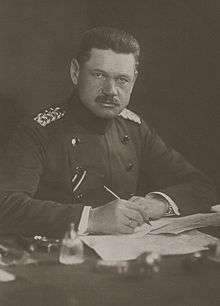Curt von Morgen
| Curt von Morgen | |
|---|---|
 Curt von Morgen during WWI | |
| Born |
1 November 1858 Neiße, Kingdom of Prussia |
| Died |
15 February 1928 (aged 69) Lübeck, Germany |
| Allegiance |
|
| Service/branch | Heer |
| Years of service | 1878–1919 |
| Rank | General of Infantry |
| Commands held |
|
| Battles/wars | |
| Awards | Pour le Mérite with Oak Leaves |
| Relations | Anthony Fokker |
Curt Ernst von Morgen (1 November 1858 in Neiße – 15 February 1928 in Lübeck) was a Prussian explorer and officer, later General of Infantry during World War I. He was a recipient of Pour le Mérite with Oak Leaves.
Explorer in Cameroon
Curt von Morgen was stationed in German Kamerun and undertook two research journeys to central Cameroon in 1889 and from 1890 to 1891. After the expeditions, Morgen returned to Germany but in 1894 he was tasked with the formation of the Kamerun Schutztruppe. He also led two military expeditions against the Abo north of Douala and the Kwe (Bakwiri) near Mount Cameroon.
The Middle East
In 1896-97, he followed as military observer the English Dongola-Expedition against the Mahdists. In 1897, he became Military Attaché in Istanbul. He followed as observer the Greco-Turkish War (1897) and prepared the visit of Kaiser William II to Palestine in 1898.
Military service in Germany
On 27 January 1912, he was promoted to Generalmajor and assigned as commander of the 81st Infantry Brigade in Lübeck. On 9 August 1913, when the emperor visited the town, he reported to him.
World War I
On mobilisation for World War I in August 1914, he became commander of the 3rd Reserve Division from Danzig, and promoted to Generalleutnant on the 19th of that month.[1] He commanded this division as part of the 8th Army in the pivotal Battle of Tannenberg at the opening of the war on the Eastern Front, and at the subsequent First Battle of the Masurian Lakes. For his performance in this period, he was awarded the Pour le Mérite on 1 December 1914.[2]
On 24 November 1914, he took over command of I Reserve Corps from Otto von Below.[3] He led this Corps for almost the entire war, only swapping places with Richard Wellman in command of XIV Reserve Corps in August 1918.[4]
With the I Reserve Corps, he fought in the Battle of Łódź (1914) and in the Romanian campaign (1916-1917) in which he took the oil fields of Ploiești and advanced towards Focșani. After the signing of the peace treaty with Romania, his Corps was moved to the Western Front.
He was awarded the Oakleaves to the Pour le Mérite (signifying a second award) on 11 December 1916.[2]
Later life
After his retirement he became General of Infanterie and returned to Lübeck.
Family
His son Heinrich-Joachim von Morgen (1902–1932) was an early German race car driver. His daughter Elizabeth married in 1923 the aircraft designer Anthony Fokker (1890-1939).
Awards
- Iron Cross of 1914, 1st and 2nd class
- Pour le Mérite (1 December 1914) and Oak Leaves (11 December 1916)
- Order of the Crown, 2nd class with Swords on rings[5]
- Knight's Cross, First Class of the Order of the Zähringer Lion with oak leaves (Baden)[5]
- Order of the Red Eagle, 2nd class with Oak Leaves and Swords on rings[5]
- Knight's Cross Second Class Order of the White Falcon[5]
- Commander of the Order of Orange-Nassau (Netherlands)[5]
- Commander of the Order of St. Michael (Bavaria)[5]
- Knight's Cross, First Class of the Ducal Saxe-Ernestine House Order (Saxon duchies)[5]
- Service Award (Prussia)[5]
- Grand Commander of the Order of the Griffon (Mecklenburg)[5]
- Cross of Merit, First Class of the Lippe House Order with Swords[5]
- Commander Second Class of the Order of the Crown (Württemberg)[5]
- Knight's Cross, First Class of the Friedrich Order (Württemberg)[5]
- Grand Officer of the Order of Military Merit (Bulgaria)
- Order of the Double Dragon, 3rd Degree, First Class
- Commander of the Order of the Crown (Romania)[5]
- Officer of the Order of the White Eagle (Serbia)[5]
- Gold Imtiaz Medal (Ottoman Empire)[5]
- Order of Osmanieh, 2nd class (Ottoman Empire)[5]
- Order of the Medjidie, 2nd class (Ottoman Empire)[5]
- Hanseatic Cross of Lübeck (2 November 1915) [9]
- Gold Liakat Medal (Ottoman Empire)[5]
References
- ↑ "Kurt von Morgen". The Prussian Machine. Retrieved 21 December 2012.
- 1 2 "Orden Pour le Mérite". Retrieved 21 December 2012.
- ↑ "Armee-Reserve-Korps". The Prussian Machine. Retrieved 21 December 2012.
- ↑ "Richard Wellmann". The Prussian Machine. Retrieved 21 December 2012.
- 1 2 3 4 5 6 7 8 9 10 11 12 13 14 15 16 17 18 Rangliste der Königlich Preußischen Armee und des XIII. (Königlich Württembergischen) Armeekorps für 1914. Berlin: Hrsg.: Kriegsministerium, Ernst Siegfried Mittler & Sohn. 1914.
- Hanns Möller: Geschichte der Ritter des Ordens pour le mérite im Weltkrieg, Band II: M–Z, Verlag Bernard & Graefe, Berlin 1935
- Florian Hoffmann: Okkupation und Militärverwaltung in Kamerun. Etablierung und Institutionalisierung des kolonialen Gewaltmonopols 1891–1914, Göttingen 2007
+ Rangliste der Königlich Preußischen Armee und des XIII. (Königlich Württembergischen) Armeekorps für 1914, Hrsg.: Kriegsministerium, Ernst Siegfried Mittler & Sohn, Berlin 1914, S.82
- Lübecker General-Anzeiger, Obituary in the Newspaper from Lübeck of 16th, 21 and 22 February 1928
| Military offices | ||
|---|---|---|
| Preceded by General der Infanterie Otto von Below |
Commander, I Reserve Corps 28 November 1914 - 25 August 1918 |
Succeeded by Generalleutnant Richard Wellman |
| Preceded by Generalleutnant Richard Wellman |
Commander, XIV Reserve Corps 25 August 1918 - 11 November 1918 |
Succeeded by Disbanded |